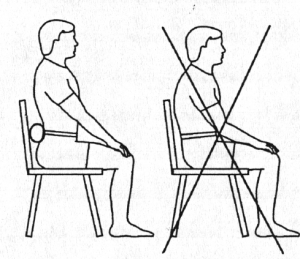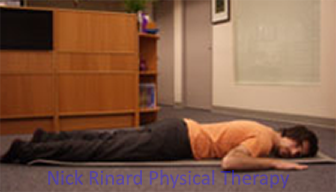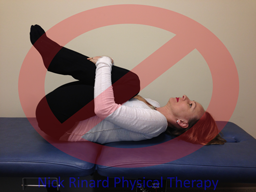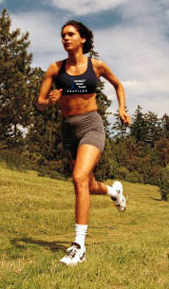Nick Rinard Physical Therapy is back from the long Memorial Day weekend– getting patients results.
If you are in pain- let us help you get rid of what ails you before the first days of summer!
“Bi-lateral flank pain. This issue does not appear to be structural, but Nick helped treat mid-to-upper back pain which was also present. I feel I have the tools and techniques to self-treat this and prevent future flare-ups. Thanks!”
John
More
By Krissy Brown
04 Feb, 2025
Clinical Case of the Week, Medical Advisory, Physical Therapy Tips
ankle pain, exercise, injured, Knee pain, Leg pain, Low Back Pain, Nick Rinard physical therapy, Physical Therapy, running, treatment
By MiKayla Sanocki, SPT
Did you know a back problem can cause symptoms such as pain, decreased strength and decreased sensations into the thigh, calf, ankle or foot? Physical therapists trained in Mechanical Diagnosis and Therapy (MDT) here at Nick Rinard Physical Therapy can determine during the evaluation if any of these lower leg symptoms are coming from your back.
Check out this bizarre clinical presentation we treated at Nick Rinard Physical Therapy:
She did not remember any trauma to the ankle
The patient came to physical therapy for an “ankle sprain” that occurred 3-months earlier. She stated she woke up unable to put any weight on her right foot. The pain had remained constant in her ankle, so bad at times that she couldn’t walk! Upon further questioning, the patient revealed what she had been doing the day before: She had driven 2 hours, on her way home from helping clean a house. During the drive she had discomfort in her buttock and hamstring that made her want to pull the car over to stretch. She did not remember any trauma to the ankle, however, but the ankle pain was the only pain she was experiencing now.
Her ankle pain has caused her to quit running and yoga — two of her favorite activities.
Mechanical Evaluation finds cause in spine
During the mechanical evaluation we found that certain directions of low back movements decreased the pain in her ankle. After being sent home with 1 simple exercise to perform every waking hour – which she did perfectly – she returned within 24 hours reporting 90% recovery in pain! Over the next week we were able to progress her exercises and now the patient reports no ankle pain at all. In only 4 visits we were able to abolish her ankle pain, and she is now getting back to running and yoga!
The patient reports, “I now have the tools to prevent the return of my back and ankle pain”.
Treatment at Nick Rinard Physical Therapy vs Traditional PT
In contrast to MDT, traditional PT would not have uncovered the spinal cause of the patient’s ankle pain. Treatment would have been ineffective since it would have focused only on trying to treat the symptom.
Do you know if your pain in the legs or arms could be coming from the spine? Schedule your evaluation at Nick Rinard Physical Therapy and find out!
More
The beginning of a new year is so exciting! A fresh start with new goals and new beginning.
If you, like so many others, have made a resolution to get healthier this year, Nick Rinard PT may be able to help.
It is very difficult to stay active when you’re in pain!
Nick Rinard Physical Therapy can help keep you on track, and can teach you how to move to prevent injuries!
Don’t allow pain to stand in the way of your 2025 goals!
Nick Rinard Physical Therapy will be closed Tuesday December 31st 2024 to Wednesday January 01 2025.
Please do not hesitate to call and leave a message and someone will be back in the office to return your phone call.
More
Nick Rinard Physical Therapy- where patients come to get results from physical therapy!
“I had lower back pain for the past 4 years & previous physical therapy visits & exercises only had temporary results.
After only 6 visits I can go back to my regularly scheduled daily HIT classes.
I’m so confident that if I had another pain issue in the future I can come back to Nick & get it fixed.”
Cara
More
Results from the heart.
Thank you Terry for sharing!
“Sometime ago, I was injured rather severely, causing a constant agonizing nerve pain. A nurse at the hospital where I was examined recommended Diagnostic Physical Therapy; namely Nick Rinard and his associates.
Under Nick’s careful supervision, these highly trained professionals diagnosed my condition and started treatment immediately, and gave explicit instructions for exercises I was to do at home between visits.
Not only did the pain improve, but also my mental outlook, as the world suddenly seemed a worthwhile place to be. Sessions took place daily at first, then weekly, and eventually my condition was so much improved that I can now live a normal life.
Nick and his team of professionals have achieved a level of care and skill I had not previously seen, with a superb knowledge of the human body, especially the arts and sciences associated with muscle, bone, nerve and sinew, as well as an unexpected understanding of one’s mental and spiritual outlook.”
Terry
More
Nick Rinard Physical Therapy has continued SAFETY MEASURES and are ALWAYS here for you!
Our staff is fully vaccinated and continues to follow social distancing, sanitation protocols and wear masks.
New patients and established patients will find every visit very valuable and should not delay care due to increases in Coronavirus cases.
We are here to diagnose, educate, offer tools, listen to concerns, and meet all safety needs of every patient.
May all our patients stay safe, healthy and have a quick recovery should they test positive for Coronavirus this summer.
Nick Rinard Physical Therapy is here for you.
More
What a year to review!
Are you having shoulder pain?
“After surgery on my left shoulder I needed a ton of help regaining movement & strength.
I can do pretty much everything that I could do before my injury now – which I didn’t expect would be possible so THANK YOU SO MUCH!“
Amanda
Are you having low back pain?
“I came after severe back pain. I was not able to bend over, walk for extended time, or sit without pain.
Right away I had better results from doing the exercises I was shown then I had ever had with my previous therapist.
I feel like we went at a good pace and throughout my treatment I have been able to increase my overall activity and quality of life.
I have been given the knowledge and tools I need to manage my pain on my own and my back pain has greatly improved!”
Danielle
Are you having knee pain?
“I chose to come here because I read such great reviews.
After reading just a few, I knew this was the place where I needed to be.
I came for my knee, but after completing physical therapy for it, it feel like a lot more than just my knee has improved.
I have better knowledge of mind and body connection, much better balance, and my whole body is stronger overall.
This office has great energy and everyone who needs physical therapy should come here! ”
Ronnie
Failed back surgery?
“I was recommended to investigate the McKenzie Method for my recover, especially as my pain had greatly increased and did not seem to be improving.
The PT folks I was seeing at that time recommend that I check you all out as practitioners of this method. Although eventually we all concluded that a follow up surgery to replace my disk is necessary.
I have much more confidence that I will be able to live a life pain-free, or much reduced.
At the moment I can stand straighter than before, can drives for a short distance if necessary, and better manage my own pain w/o opioids.”
Brian
Let your New Year resolution be one of these testimonials.
Rid yourself of pain and get back to pre-injury/surgery levels!
More
LOW BACK PAIN—What you should do while waiting for your first physical therapy appointment…
SITTING:
 Sit as little as possible. Standing or lying down are preferable to sitting when in acute low back pain. If you must sit, sit only in a straight backed chair with good posture. Avoid couches or soft chairs. Use a towel roll to support the natural curve of your spine.
Sit as little as possible. Standing or lying down are preferable to sitting when in acute low back pain. If you must sit, sit only in a straight backed chair with good posture. Avoid couches or soft chairs. Use a towel roll to support the natural curve of your spine.
BENDING:
Do not bend forwards as in touching your toes when in acute low back pain—even if it feels like you are doing good by “stretching” the muscles of the low back. Rather than reaching down to get things, squat down using the legs and keep the back absolutely straight.
LYING:
Try to lie more on your stomach rather than on your back. Avoid the temptation to lie on your back with the head and knees propped up—this just rounds the back more and places inappropriate stress on injured structures.

EXERCISES:
You should stay normally active–in other words try not to stay in bed for long periods. Move around, take walk if you can. Do not do the knees to chest exercise you may have learned before. This is an advanced exercise and usually not appropriate for acute conditions. It is better in most cases to lie on your stomach and work towards supporting yourself on the elbows.
 |
 |
| NO! |
YES! |
More
BACKGROUND:
Up to 80% of the population will experience low back pain (LBP) at some point in their adult life (Croft et al 1997). It is estimated that health care costs for low back pain are larger than for any other disease for which economic analysis is available (Maniadakis and Gray 2000) ($31 billion/year). There is little to no evidence supporting the use of traction, thermal modalities, or electrical stimulation for the treatment of LBP. Unfortunately, these strategies are commonly used for the bulk of LBP treatment. Many studies conclude that the McKenzie method of evaluation and treatment for LBP is superior to that of standard treatment (general stretching and strengthening). What makes the McKenzie approach different is its classification system. Based off of symptom response to repeated lumbar spine movements, patients are classified into 1 of 3 syndromes (derangement, dysfunction, postural). After patients have been classified, their individualized treatment plan is created. The McKenzie method also emphasizes self-treatment and long term symptom management. I consider this the most valued aspect of treatment, as statistics show LBP is recurring in nature. Let’s review a case of a patient with a very successful outcome utilizing the McKenzie method.
SYMPTOMS:
Patient presented to therapy 2 weeks after the onset of LBP with bilateral leg pain. Patient described sharp pain which radiated down to the left foot and down to the right shin. Symptoms started after a weekend of working (auto mechanic) which involved repetitive bending and lifting of heavy equipment. Patient rated worst pain as an 11/10 for the back and a 10/10 for the left leg, occurring on a daily basis. Patient was severely limited with walking, sitting and sleep.
THERAPIST’S EVALUATION AND FINDINGS:
Patient demonstrated pain with all lumbar spine motions in standing. There was no neurological (strength, sensory, reflex, neural tension) deficit. This is important to test when there is a presence of leg pain.
Baseline symptoms= LBP + left foot tingling. Patient was asked to bend forward 10 times, touching his toes. This resulted in increased low back pain, no effect on foot tingling. Bending backwards 10 times also increased LBP with no effect on foot tingling. Patient was then asked to lie on his stomach and perform prone press ups (a back bend using arms to push up into extension). This exercise abolished left foot symptoms, better leaving the clinic that day.
PATIENT HOMEWORK AND OUTCOMES:
Patient was given prone press-ups to be done every hour until his follow up appointment. The next day, the patient returned to the clinic happily reporting that he had not experienced leg pain in over 24 hours! The patient was even able to perform tasks associated with moving into his new home that weekend. In 2 weeks his back pain rating had decreased to a 3/10 and he was experiencing little to no leg symptoms! Patient continued therapy over the next few months with exercise progressions and modifications as needed. At discharge, patient was able to perform his duties as an auto mechanic and continue his training as a member of the National Guard.
HAVE A MECHANICAL EVALUATION FOR YOUR LOW BACK PAIN:
Do not fall victim to chronic low back pain. This is associated with huge healthcare costs, over utilization of medication and surgery. All of which would otherwise be avoided with a simple exercise, requiring no special equipment. The patient from this week’s case left the clinic feeling very empowered by his own ability to treat his symptoms and was no longer considering having major spine surgery.
More





